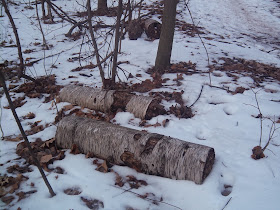As part of my devotion to mother nature and my love for plants and trees, I am participating in a wonderful project. This year is the UN International Year of the Forests, and this weblog project, The Tree Year, is a beautiful way to get people to pay attention to the trees and to share their findings.
A whole year of observing one tree? Oh my. That is a very tall order. Not because I don't want to spend all year observing trees - its just that only one tree would be near impossible for me. So while I will forgive myself if this expounds into a forest itself, I will, at least, begin with one kind of tree. Sort of.
I have spend my fair share of time devoted to the Black Birch tree, because it was abundant where I was living. In my new abode, there are less black birches, but copious amounts of white, paper, and grey birches. They are absolutely stunning to me, and I know I will naturally be watching them each day and hopefully learning a bit about their magic and medicine. I have paid tribute in my title photograph. I intend to keep the title photo reserved for these trees for the duration of the tree year, and will be posting observations and learnings from time to time. I hope you will be inspired to be a part of the tree year, too.
So far, I am mostly just absorbing their presence: they rarely get gigantic like the mighty oaks, but some of them do manage to get pretty muscular and big. I think my first order will be to learn more clearly the difference between the species, as they are more tricky to identify in real life than they are when looking at pictures in a book or on a website. Especially considering it is winter here, with no leaves to assist me. Many of them grow in groves along the edges of mixed woods, where there is dappled sunlight and usually good water supply somewhere near, like a river, although they don't seem to like wet feet as the willows and alders do, but more the rocky hillsides and clearings. Some of them stand alone as ornamental trees, highlighting colonial homes in the area.
The decomposing birches offer plentiful food for a variety of woodpeckers. As you can see, the different shaped holes indicate different types of woodpeckers. The rectangle shape in particular is that of my favorite, the grand pileated woodpecker. Little ladderbacks and downy woodpeckers look at home with their matching colors of grey, black, and white.
And although I haven't come across any yet, birches are the main host for a wonderful medicinal mushroom known as chaga. These winter colored trees seem to take good company with the scrub pine, beech, hemlock, oak, and maple trees. There is plenty of moss and a beautiful red soil I am learning is a red sandstone.
The birches I see here, in Massachusetts, are so elegant. They stand with this delicate snowy skin as if the North Winds are never far behind. Like the bones of the forest, all wise and standing strong like Grandmother. I know this tree - this trio - has much to teach me. And so I watch and listen.












Thank you for participating in the Tree Year Project. Birches are really something special!
ReplyDeletewhat a lovely introdcution to your trees! I love birches too!
ReplyDeleteI have to admit that I have a difficult time focusing on just -one- thing. I've tried for a few years to focus on one herb a year to learn, but I think I'm going to copy you on this one! I can make it one "food" plant, one "medicinal" plant, and one tree. I've always wanted to know more about trees... now I just need to decide which one!
ReplyDeleteThanks for the idea!
beautiful photographs as always ananda!
ReplyDeleteWhat a great/sweet write up about birch, thanks! I miss them, having moved from the midwest to the pacific northwest. I know they are around here, but those pictures of the paper birches in the soft winter sunlight makes my heart ache.
ReplyDelete